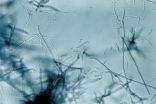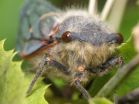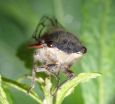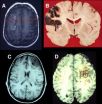(Press-News.org) When NOAA's GOES-West satellite captured an image of what is now Tropical Storm Marie, weakened from hurricane status on August 28, the strongest thunderstorms were located in the southern quadrant of the storm.
NOAA's GOES-West satellite captured an image of Marie on August 28 at 11 a.m. EDT. Bands of thunderstorms circled the storm especially to the north. The National Hurricane Center noted that Marie has continued to produce a small area of convection (rising air that forms the thunderstorms that make up Marie) south and east of the center during some hours on the morning of August 28. The GOES image was created by the NASA/NOAA GOES Project at NASA's Goddard Space Flight Center in Greenbelt, Maryland.
Infrared data, such as that from the Atmospheric Infrared Sounder instrument aboard NASA's Aqua satellite showed that cloud tops had warmed. Warming cloud tops means that the strength in the uplift of air (that pushes cloud tops higher into the colder levels of the atmosphere) has weakened, and clouds are not getting as high as they did before. The higher the thunderstorms, the stronger they usually are, but Marie's are dropping in height.
Marie is not able to generate strong thunderstorms because it has moved over cooler waters. Sea surface temperatures of at least 80 F (26.6 C) are needed to maintain a hurricane's strength. Marie is in waters as cool as 22C (71.6F).
At 11 a.m. EDT (1500 UTC) Marie's maximum sustained winds were down to 45 mph (75 kph) and weakening. Marie was centered near latitude 25.4 north and longitude 128.9 west, about 865 miles (1,395 km) west of Punta Eugenia, Mexico. Marie is moving northwest at 15 mph (24 kph).
The NHC expects Marie should become post-tropical by tonight, August 28. Meanwhile Marie continues kicking up rough surf. Large southerly swells affecting much of the west coast of the Baja California peninsula and the coast of southern California will gradually subside through Friday, August 29. These swells could still produce life-threatening surf and rip currents, as well as minor coastal flooding around the time of high tide.
INFORMATION:
Text credit: Rob Gutro
NASA's Goddard Space Flight Center
NASA sees a weaker Tropical Storm Marie
2014-08-28
ELSE PRESS RELEASES FROM THIS DATE:
DeVincenzo study breakthrough in RSV research
2014-08-28
MEMPHIS, Tenn. – The New England Journal of Medicine published research results on Aug. 21 from a clinical trial of a drug shown to safely reduce the viral load and clinical illness of healthy adult volunteers intranasally infected with respiratory syncytial virus (RSV).
Le Bonheur Children's Hospital and the University of Tennessee Health Science Center researcher Infectious Disease Specialist John DeVincenzo, MD, is lead author of this study.
RSV is the most common cause of lower respiratory tract infections in young children in the United States and worldwide. ...
Small molecule acts as on-off switch for nature's antibiotic factory
2014-08-28
DURHAM, N.C. -- Scientists have identified the developmental on-off switch for Streptomyces, a group of soil microbes that produce more than two-thirds of the world's naturally derived antibiotic medicines.
Their hope now would be to see whether it is possible to manipulate this switch to make nature's antibiotic factory more efficient.
The study, appearing August 28 in Cell, found that a unique interaction between a small molecule called cyclic-di-GMP and a larger protein called BldD ultimately controls whether a bacterium spends its time in a vegetative state or ...
Second-hand e-cig smoke compared to regular cigarette smoke
2014-08-28
E-cigarettes are healthier for your neighbors than traditional cigarettes, but still release toxins into the air, according to a new study from USC.
Scientists studying secondhand smoke from e-cigarettes discovered an overall 10-fold decrease in exposure to harmful particles, with close-to-zero exposure to organic carcinogens. However, levels of exposure to some harmful metals in second-hand e-cigarette smoke were found to be significantly higher.
While tobacco smoke contains high levels of polycyclic aromatic hydrocarbons – cancer-causing organic compounds – the level ...
Healthy Moms program helps women who are obese limit weight gain during pregnancy
2014-08-28
PORTLAND, Ore., August 28, 2014 — A new study finds that women who are obese can limit their weight gain during pregnancy using conventional weight loss techniques including attending weekly group support meetings, seeking advice about nutrition and diet, and keeping food and exercise journals.
Results of the Healthy Moms study, published in Obesity, also show that obese women who limit their weight gain during pregnancy are less likely to have large-for-gestational age babies which can complicate delivery and increase the baby's risk of becoming obese later in life.
"Most ...
University of Montana cicada study discovers 2 genomes that function as 1
2014-08-28
MISSOULA, Mont. – Two is company, three is a crowd. But in the case of the cicada, that's a good thing.
Until a recent discovery by a University of Montana research lab, it was thought that cicadas had a symbiotic relationship with two important bacteria that live within the cells of its body. Since the insect eats a simple diet consisting solely of plant sap, it relies on these bacteria to produce the nutrients it needs for survival.
In exchange, those two bacteria, Hodgkinia and Sulcia, live comfortably inside the cicada. Since all three divvy up the nutritional roles, ...
Non-adaptive evolution in a cicada's gut
2014-08-28
Organisms in a symbiotic relationship will often shed genes as they come to rely on the other organism for crucial functions. But now researchers have uncovered an unusual event in which a bacterium that lives in a type of cicada split into two species, doubling the number of organisms required for the symbiosis to survive.
Cicadas of the genus Tettigades feed only on sap they suck out of plants. To create some of the essential amino acids they rely on two bacterial helpers — Candidatus Hodgkinia cicadicola and Candidatus Sulcia muelleri — with which they have lived in ...
How studying damage to the prefrontal lobe has helped unlock the brain's mysteries
2014-08-28
Until the last few decades, the frontal lobes of the brain were shrouded in mystery and erroneously thought of as nonessential for normal function—hence the frequent use of lobotomies in the early 20th century to treat psychiatric disorders. Now a review publishing August 28 in the Cell Press journal Neuron highlights groundbreaking studies of patients with brain damage that reveal how distinct areas of the frontal lobes are critical for a person's ability to learn, multitask, control their emotions, socialize, and make real-life decisions. The findings have helped experts ...
Circulating tumor cell clusters more likely to cause metastasis than single cells
2014-08-28
Circulating tumor cell (CTC) clusters – clumps of from 2 to 50 tumor cells that break off a primary tumor and are carried through the bloodstream – appear to be much more likely to cause metastasis than are single CTCs, according to a study from investigators at the Massachusetts General Hospital (MGH) Cancer Center. Their report in the August 28 issue of Cell also suggests that a cell adhesion protein binding CTC clusters together is a potential therapeutic target.
"While CTCs are considered to be precursors of metastasis, the significance of CTC clusters, which are ...
NYU researchers ID process producing neuronal diversity in fruit flies' visual system
2014-08-28
New York University biologists have identified a mechanism that helps explain how the diversity of neurons that make up the visual system is generated.
"Our research uncovers a process that dictates both timing and cell survival in order to engender the heterogeneity of neurons used for vision," explains NYU Biology Professor Claude Desplan, the study's senior author.
The study's other co-authors were: Claire Bertet, Xin Li, Ted Erclik, Matthieu Cavey, and Brent Wells—all postdoctoral fellows at NYU.
Their work, which appears in the latest issue of the journal Cell, ...
Zombie bacteria are nothing to be afraid of
2014-08-28
VIDEO:
Heidi Arjes of Washington University in St. Louis explains how the failsafes in the bacterial cell cycle work. A bacterium that fails to pass either failsafe enters a zombified state...
Click here for more information.
A cell is not a soap bubble that can simply pinch in two to reproduce. The ability to faithfully copy genetic material and distribute it equally to daughter cells is fundamental to all forms of life. Even seemingly simple single-celled organisms must have ...






